The global pro collagen ingredient market is projected to grow from USD 333.5 million in 2025 to USD 705 million by 2035, registering a CAGR of 7.8%.
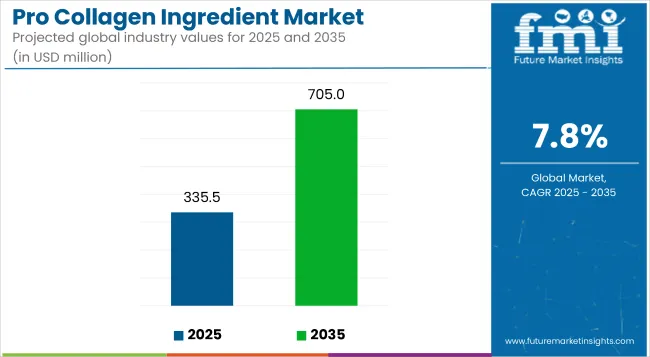
| Metric | Value |
|---|---|
| Industry Size (2025E) | USD 333.5 million |
| Industry Value (2035F) | USD 705 million |
| CAGR (2025 to 2035) | 7.8% |
The market expansion is being driven by rising consumer awareness regarding anti-aging and skin health benefits offered by pro collagen ingredients. The growing demand for cosmetic and personal care products fortified with collagen-boosting ingredients is encouraging manufacturers to integrate pro collagen components like hyaluronic acid, vitamin C, and retinol into their formulations.
Advanced pro collagen ingredients with superior absorption, natural sourcing, and multifunctional benefits are gaining traction across applications including skincare, dietary supplements, and functional beverages, contributing to broader market adoption.
The market holds varied shares across its parent markets. It accounts for 100% of the collagen ingredient segment, reflecting its niche dominance. Within the functional food ingredients market, it contributes around 12%, driven by rising beauty-from-within trends.
In the cosmetic ingredients market, its share is nearly 6%, as hyaluronic acid, vitamin C, and retinol gain traction. It contributes 3% to the global anti-aging products market, given its skin rejuvenation benefits. However, its share in the vast food and beverage ingredients market remains minimal, below 0.02%, highlighting its specialised but rapidly expanding nature in beauty and nutraceutical sectors.
Government regulations impacting the market focus on ingredient safety, labeling standards, and health claims. The Food Safety and Standards Authority of India (FSSAI) regulations, European Commission guidelines on cosmetic ingredients (EC No 1223/2009), and FDA requirements in the United States set strict standards for ingredient purity, permissible usage limits, and marketing claims to ensure consumer safety.
Additionally, regulations such as REACH in Europe govern the safe sourcing and environmental impact of bioactive ingredients. These regulatory frameworks drive the adoption of scientifically validated, clean-label, and sustainably sourced pro collagen ingredients, ensuring compliance and enhancing consumer trust in the products.
Japan is projected to be the fastest-growing market, expected to expand at a CAGR of 8.2% from 2025 to 2035. In terms of end use, cosmetic and personal care products will lead the market with a 40% share. Ingredient type, hyaluronic acid will dominate with a 30% share in 2025. The USA and Germany markets are also expected to grow steadily, with CAGRs of 7% and 6.5%, respectively. The UK market is projected to grow at a CAGR of 6.8%, while France will expand at 6.2% during the same period.
The market is segmented by ingredient type, end use, and region. By ingredient type, the market is divided into peptides, hyaluronic acid, vitamin C, retinol (vitamin A), vitamin E, niacinamide (vitamin B3), and others (elastin, BHAs, ceramides). Based on end use, the market is segmented into dietary supplements, cosmetic and personal care products, sports and fitness products, and nutritional beverages. Regionally, the market is classified into North America, Latin America, Europe, East Asia, South Asia, Oceania, and the Middle East & Africa.
Hyaluronic acid is expected to dominate the ingredient type segment with a 30% market share in 2025, owing to its superior moisture retention, collagen-boosting properties, and widespread use in effective skincare formulations globally.
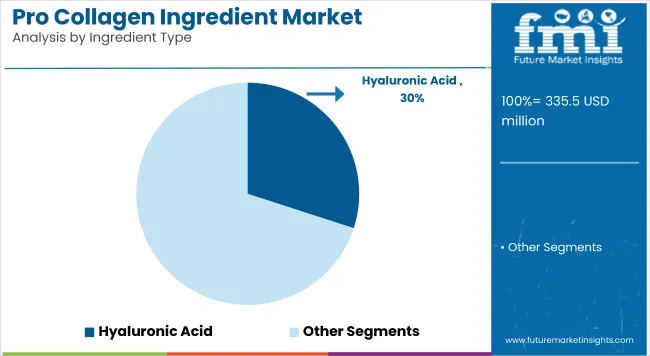
Cosmetic and personal care products are expected to dominate the end use segment, accounting for 40% of the global market share in 2025, driven by rising demand for anti-aging creams, serums, and skincare formulations with collagen-boosting benefits.
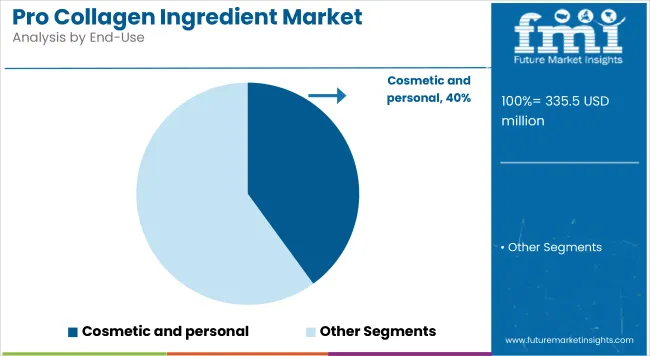
The global pro collagen ingredient market is experiencing robust growth, driven by increasing consumer demand for anti-aging and skin-enhancing products. Pro collagen ingredients play a crucial role in boosting skin hydration, elasticity, and overall youthful appearance.
Recent Trends in the Pro Collagen Ingredient Market
Challenges in the Pro Collagen Ingredient Market
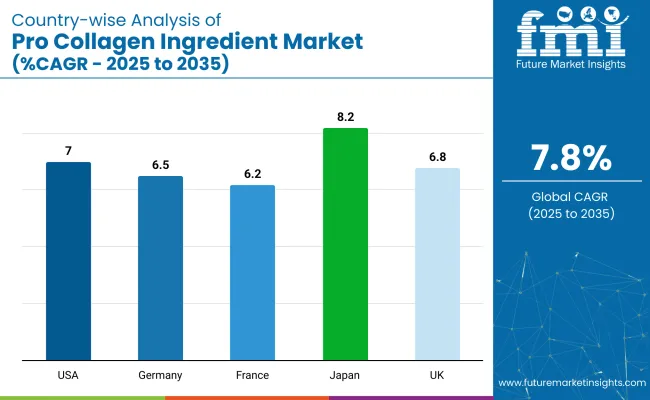
Japan momentum is driven by advanced skincare innovation, beauty tech integration, and regulatory alignment with natural and clean-label cosmetic standards. Germany and France maintain consistent demand driven by EU cosmetic safety mandates and funding for bioactive ingredient research. In contrast, developed economies such as the USA (7% CAGR), UK (6.8%), and Japan (8.2%) are expected to expand at a steady 0.90-1.05x of the global growth rate.
Japan is projected to record the fastest growth in the pro collagen ingredient market, driven by strong demand for high-performance and multifunctional skincare solutions. The USA follows with steady expansion supported by innovation in premium anti-aging products. The UK shows moderate growth, influenced by clean-label and vegan trends despite post-Brexit investment caution.
Germany maintains stable growth with its focus on clinical validation and dermatologist-backed formulations. France records the slowest growth among these nations, driven by sustainably sourced and vegan ingredient preferences. Japan leads in market momentum, while France and Germany remain regulation and compliance driven in their growth trajectories.
The report covers in-depth analysis of 40 plus countries; five top-performing OECD countries are highlighted below.
The Japan pro collagen ingredient revenue is growing at a CAGR of 8.2% from 2025 to 2035. Growth is driven by demand for high-performance skincare solutions focusing on hydration, elasticity, and wrinkle reduction. As a technology-driven OECD economy, Japan prioritizes advanced formulations with hyaluronic acid, peptides, and vitamin C in premium skincare brands.
The sales of pro collagen ingredients in Germany are expected to expand at 6.5% CAGR during the forecast period, slightly below the global average but strongly regulation-led. EU cosmetic directives, clean-label movements, and dermocosmetic research are pushing adoption of advanced collagen-boosting ingredients.
The France pro collagen ingredient market is projected to grow at a 6.2% CAGR during the forecast period, reflecting a policy-backed adoption trajectory. Demand is driven by national clean beauty standards, cosmetic safety regulations, and premium skincare product launches. Manufacturing sectors such as pharmaceuticals, cosmetics, and dermocosmetics are major consumers.
The USA pro collagen ingredient market is projected to grow at 7% CAGR from 2025 to 2035, translating to 0.90x the global rate. Unlike emerging markets focused on volume, USA demand is driven by innovation in multifunctional skincare formulations, FDA-approved health claims, and premium brand positioning.
The UK pro collagen ingredient revenue is projected to grow at a CAGR of 6.8% from 2025 to 2035, representing the slowest growth among the top OECD nations, at 0.87 times the global pace. Growth is supported by clean-label, vegan, and dermatologist-approved skincare trends. Post-Brexit regulatory divergence has slightly slowed innovation investments.
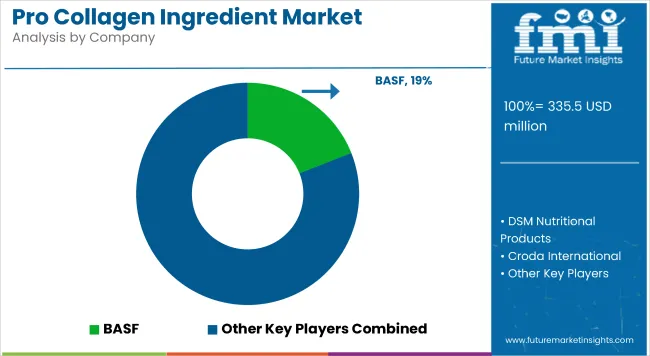
The market is moderately consolidated, with leading players like BASF, DSM Nutritional Products, Croda International, Ashland, and Solvay dominating the industry. These companies provide advanced, high-quality pro collagen ingredients catering to industries such as cosmetics, personal care, and nutraceuticals. BASF focuses on innovative bioactive ingredients with proven efficacy, while DSM Nutritional Products specializes in premium vitamins and collagen-boosting solutions.
Croda International delivers sustainable and science-backed skincare ingredients. Ashland offers multifunctional pro collagen ingredients enhancing texture and performance, while Solvay is known for its high-purity actives for skin health. Other key players like Givaudan, Roquette, Kobo Products Inc., Lucas Meyer Cosmetics, Seppic, Greentech, Lipotec, Lonza Group, TRI-K Industries, Bio-Nest Biochemical Technologies, and Selleck Chemicals contribute by providing specialized, scientifically validated ingredients for a wide range of skincare and nutricosmetic applications.
Recent Pro Collagen Ingredient Industry News
| Report Attributes | Details |
|---|---|
| Market Size (2025) | USD 333.5 million |
| Projected Market Size (2035) | USD 705 million |
| CAGR (2025 to 2035) | 7.8% |
| Base Year for Estimation | 2024 |
| Historical Period | 2020 to 2024 |
| Projections Period | 2025 to 2035 |
| Report Parameter | USD million for value/volume in metric tons |
| Ingredient Type Analyzed | Peptides, Hyaluronic Acid, Vitamin C, Retinol (Vitamin A), Vitamin E, Niacinamide (Vitamin B3), and Others (Elastin, BHAs, Ceramides) |
| End Use Analyzed | Dietary Supplements, Cosmetic and Personal Care Products, Sports & Fitness Products, and Nutritional Beverages |
| Regions Covered | North America, Latin America, Europe, East Asia, South Asia, Oceania, Middle East & Africa |
| Countries Covered | United States, United Kingdom, Germany, France, Japan, China, India, Brazil, South Korea, Australia |
| Key Players Influencing the Market | BASF, DSM Nutritional Products, Croda International, Ashland, Solvay, Givaudan, Roquette, Kobo Products Inc., Lucas Meyer Cosmetics, Seppic, Greentec, Lipotec, Lonza Group, TRI-K Industries, Bio-Nest Biochemical Technologies, Selleck Chemicals |
| Additional Attributes | Dollar sales by ingredient type, share by end use, regional demand growth, policy influence, clean-label trends, competitive benchmarking |
The market is valued at USD 333.5 million in 2025.
The market is forecasted to reach USD 705 million by 2035, reflecting a CAGR of 7.8%.
Cosmetic and personal care products will lead the end use segment, accounting for 40% of the global market share in 2025.
Hyaluronic acid will dominate the ingredient type segment with a 30% share in 2025.
Japan is projected to grow at the fastest rate, with a CAGR of 8.2% from 2025 to 2035.






Our Research Products

The "Full Research Suite" delivers actionable market intel, deep dives on markets or technologies, so clients act faster, cut risk, and unlock growth.

The Leaderboard benchmarks and ranks top vendors, classifying them as Established Leaders, Leading Challengers, or Disruptors & Challengers.

Locates where complements amplify value and substitutes erode it, forecasting net impact by horizon

We deliver granular, decision-grade intel: market sizing, 5-year forecasts, pricing, adoption, usage, revenue, and operational KPIs—plus competitor tracking, regulation, and value chains—across 60 countries broadly.

Spot the shifts before they hit your P&L. We track inflection points, adoption curves, pricing moves, and ecosystem plays to show where demand is heading, why it is changing, and what to do next across high-growth markets and disruptive tech

Real-time reads of user behavior. We track shifting priorities, perceptions of today’s and next-gen services, and provider experience, then pace how fast tech moves from trial to adoption, blending buyer, consumer, and channel inputs with social signals (#WhySwitch, #UX).

Partner with our analyst team to build a custom report designed around your business priorities. From analysing market trends to assessing competitors or crafting bespoke datasets, we tailor insights to your needs.
Supplier Intelligence
Discovery & Profiling
Capacity & Footprint
Performance & Risk
Compliance & Governance
Commercial Readiness
Who Supplies Whom
Scorecards & Shortlists
Playbooks & Docs
Category Intelligence
Definition & Scope
Demand & Use Cases
Cost Drivers
Market Structure
Supply Chain Map
Trade & Policy
Operating Norms
Deliverables
Buyer Intelligence
Account Basics
Spend & Scope
Procurement Model
Vendor Requirements
Terms & Policies
Entry Strategy
Pain Points & Triggers
Outputs
Pricing Analysis
Benchmarks
Trends
Should-Cost
Indexation
Landed Cost
Commercial Terms
Deliverables
Brand Analysis
Positioning & Value Prop
Share & Presence
Customer Evidence
Go-to-Market
Digital & Reputation
Compliance & Trust
KPIs & Gaps
Outputs
Full Research Suite comprises of:
Market outlook & trends analysis
Interviews & case studies
Strategic recommendations
Vendor profiles & capabilities analysis
5-year forecasts
8 regions and 60+ country-level data splits
Market segment data splits
12 months of continuous data updates
DELIVERED AS:
PDF EXCEL ONLINE
Protein Ingredients Market Analysis - Size, Share, and Forecast 2025 to 2035
Probiotic Ingredients Market Analysis - Size, Share, and Forecast Outlook 2025 to 2035
Market Share Breakdown of Probiotic Ingredients
Soy Protein Ingredients Market Size and Share Forecast Outlook 2025 to 2035
Soy Protein Ingredient Market Size and Share Forecast Outlook 2025 to 2035
UK Probiotic Ingredients Market Analysis – Size, Growth & Industry Trends 2025-2035
Pea Protein Ingredients Market Insights - Plant-Based Nutrition Growth 2025 to 2035
Whey Protein Ingredients Market Size and Share Forecast Outlook 2025 to 2035
USA Probiotic Ingredients Market Insights – Demand, Share & Forecast 2025-2035
Probiotic Skincare Ingredients Market Size and Share Forecast Outlook 2025 to 2035
Analysis and Growth Projections for Protein Hydrolysate Ingredient Market
ASEAN Probiotic Ingredients Market Outlook – Growth, Size & Forecast 2025–2035
Europe Probiotic Ingredients Market Trends – Growth, Demand & Forecast 2025-2035
Marine Collagen-Based Products Market Analysis - Size, Share, and Forecast Outlook 2025 to 2035
Australia Probiotic Ingredients Market Report – Demand, Trends & Innovations 2025-2035
Native Whey Protein Ingredients Market
Blue Light Protection Ingredient Market Size and Share Forecast Outlook 2025 to 2035
Competitive Landscape of Blue Light Protection Ingredient Providers
Latin America Probiotic Ingredients Market Outlook – Size, Share & Forecast 2025-2035
Product Tour Software for SaaS Market Size and Share Forecast Outlook 2025 to 2035

Thank you!
You will receive an email from our Business Development Manager. Please be sure to check your SPAM/JUNK folder too.
Chat With
MaRIA